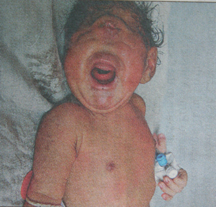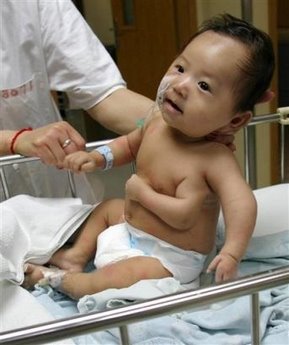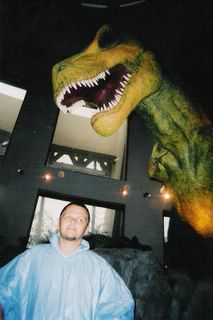Warning: Face May Turn Black & Ooze Off

A Tale of Two Faces: Plans Advancing for World's First Face Transplant
from First Coast News
CLEVELAND - In the next few weeks, five men and seven women will secretly visit the Cleveland Clinic to interview for the chance to have a radical operation that's never been tried anywhere in the world.
They will smile, raise their eyebrows, close their eyes, open their mouths. Dr. Maria Siemionow will study their cheekbones, lips and noses. She will ask what they hope to gain and what they most fear.
Then she will ask, "Are you afraid that you will look like another person?"
Because
 >whoever she chooses will endure the ultimate identity crisis. Siemionow wants to attempt a face transplant.
>whoever she chooses will endure the ultimate identity crisis. Siemionow wants to attempt a face transplant.This is no extreme TV makeover. It is a medical frontier being explored by a doctor who wants the public to understand what she is trying to do.
It is this: To give people horribly disfigured by burns, accidents or other tragedies a chance at a new life. Today's best treatments still leave many of them with freakish, scar-tissue masks that don't look or move like natural skin.
These people already have lost the sense of identity that is linked to the face; the transplant is merely "taking a skin envelope" and slipping their identity inside, Siemionow contends.
Her supporters note her experience, careful planning, the team of experts assembled to help her, and the practice she has done on animals and dozens of cadavers to perfect the technique.
But her critics say the operation is way too risky for something that is not a matter of life or death, as organ transplants are. They paint the frighteningly surreal image of a worst-case scenario: a transplanted face being rejected and sloughing away, leaving the patient worse off than before.
Such qualms recently scuttled face transplant plans in France and England. Ultimately, it comes to this: a hospital, doctor and patient willing to try it.
The first two are now in place. The third is expected to be shortly.
The "consent form" says that this surgery is so novel and its risks so unknown that doctors don't think informed consent is even possible.
Here is what it tells potential patients: Your face will be removed and replaced with one donated from a cadaver, matched for tissue type, age, sex and skin color. Surgery should last 8 to 10 hours; the hospital stay, 10 to 14 days. Complications could include infections that turn your new face black and require a second transplant or reconstruction with skin grafts. Drugs to prevent rejection will be needed lifelong, and they raise the risk of kidney damage and cancer. After the transplant you might feel remorse, disappointment, or grief or guilt toward the donor. The clinic will try to shield your identity, but the press likely will discover it.
Another form tells donor families that the person receiving the face will not resemble their dead loved one. The recipient should look similar to how he or she did before the injury because the new skin goes on existing bone and muscle, which give a face its shape.
All of the little things that make up facial expression - mannerisms like winking when telling a joke or blushing at a compliment - are hard-wired into the brain and personality, not embedded in the skin.
Some research suggests the end result would be a combination of the two appearances.
The clinic will cover costs for the first patient; nothing about others has been decided.
It took more than a year to win approval from the 13-member Institutional Review Board, the clinic's gatekeeper of research. At first, not everyone was on her side, acknowledged the board's vice chairman, Dr. Alan Lichtin. After months of debate, Siemionow brought in photographs of potential patients.
Looking at the contorted images, Lichtin said he was struck by "the failure of the present state of the art to help these people." He decided he didn't want to deprive the surgeon or patients of the chance.
The board's decision didn't have to be unanimous. In the end, it was. Surgeons wished they could have done a transplant six years ago, when a 2-year-old boy attacked by a pit bull dog was brought to the University of Texas in Dallas where Dr. Karol Gutowski was training.
Other doctors had tried to reattach part of the boy's mauled face but it didn't take. The Texas surgeons did five skin grafts in a bloody, 28-hour surgery. Muscles from the boy's thigh were moved to around his mouth. Part of his abdomen became the lower part of his face. Two forearm sections became lips and mouth.
"He'll never be normal," said Gutowski, now a reconstructive surgeon at the University of Wisconsin-Madison.
Surviving
 such wounds can be "life by 1,000 cuts." Patients endure dozens of operations to graft skin inch by inch from their backs, arms, buttocks and legs. Only small amounts can be taken at a time because of bleeding.
such wounds can be "life by 1,000 cuts." Patients endure dozens of operations to graft skin inch by inch from their backs, arms, buttocks and legs. Only small amounts can be taken at a time because of bleeding.Surgeons often return to the same areas every few weeks, reopening old wounds and building up skin. Years later, many patients are still having surgeries. A face transplant - applying a sheet of skin in one operation - could be a better solution.
Despite its shock factor, it involves routine microsurgery. One or two pairs of veins and arteries on either side of the face would be connected from the donor tissue to the recipient. About 20 nerve endings would be stitched together to try to restore sensation and movement. Tiny sutures would anchor the new tissue to the recipient's scalp and neck, and areas around the eyes, nose and mouth.
"For 10 years now, it could have been done," said Dr. John Barker, director of plastic surgery research at the University of Louisville, where the first hand transplant in the United States was performed in 1999.
Several years ago, these doctors announced their intent to do face transplants, but no hospital has yet agreed. They also are working with doctors in the Netherlands; nothing is imminent.
However, Siemionow had been doing experimental groundwork. She already had creatures that resembled raccoons in reverse - white rats with masks of dark fur - from years of face transplant experiments. She developed a plan and got clinic approval before going public, and insists she is not competing to do the first case.
She wants a clear-cut first case. No children because risks are too great. No cancer patients because anti-rejection drugs raise the risk of recurrence.
"You want to choose patients who are really disfigured, not someone who has a little scar," yet with enough healthy skin for traditional grafts if the transplant fails, she said.
Dr. Joseph Locala will decide whether candidates are mentally fit. His chief concern: making sure they realize the risks. A psychiatrist who has worked with transplant patients for 11 years, Locala knows they often have been coached on what to say to be chosen. He'd veto candidates who had abused alcohol or drugs, because they may not comply with medications. Likewise someone who had attempted or seriously threatened suicide, or with little family or friends for support.
"I'm looking for a psychologically strong person. We want people who are going to make it through," he explained.
Matthew Teffeteller might seem an ideal candidate. Hair is driving him crazy. What used to be a beard can't grow through the skin-graft quilt that Vanderbilt University doctors stitched over parts of his face that were seared off in a car crash. Trapped under this crust, hair festers, leading to staph infections, pain, and more surgeries. "It's a nightmare and it never ends," he said. "Being burned is the worst thing that can happen to you. I'm about sure of it."
Teffeteller, 26, lives south of Knoxville, in the foothills of Great Smoky Mountains National Park where he worked, ironically, as a fire fighter. The day after Valentine's Day in 2002, he was taking his pregnant wife to buy a cowboy hat and go country line dancing to celebrate their first anniversary. "The next thing I remember, everything just went all to pieces...there was a big explosion. I remember seeing gas splash off of the windshield," he said. Rear-ended by a truck, his car flipped and caught on fire. His wife died. He was burned trying to free her. "They said my face was charcoal black," he said. He didn't see it for two months, until he glimpsed a mirror on his way to therapy. "Oh, my God," he thought. "I remember seeing my eyes pulled open. I remember my ears were burned off, and I remember my bottom lip being pulled down."
Three years later, his face still frightens children. Yet he wouldn't try a transplant. "Having somebody else's face...that wouldn't be right. When I look in the mirror, I might be scarred but I can still tell that it's me," he said. "I'd be afraid something would go wrong, too. What would you do if you didn't have a face? Could you live?"
Bioethicist
 Carson Strong at the University of Tennessee wonders, too. "It would leave the patient with an extensive facial wound with potentially serious physical and psychological consequences," he wrote last summer in the American Journal of Bioethics.
Carson Strong at the University of Tennessee wonders, too. "It would leave the patient with an extensive facial wound with potentially serious physical and psychological consequences," he wrote last summer in the American Journal of Bioethics.Such worries led the Royal College of Surgeons in England and the French National Ethics Advisory Committee to decide it shouldn't be tried. Any doctor considering it should examine soul and conscience, Strong wrote.
Ironically, people most emotionally devastated by disfigurement are those most likely to seek a transplant and least able to cope with uncertain results, media attention and loss of privacy, ethicists from England wrote in the same journal.
One worried that a donor family might have unhealthy expectations of seeing a loved-one "live on" in another person's body, or that recipients might want to see and approve a potential face.
No way, said Siemionow. "It's not a shopping mall. They need to rely on our judgment.
If they are starting to shop, they are not good candidates," she said.
Siemionow said critics should admit that risks and need for the transplant are debatable.
"Really, who has the right to decide about the patient's quality of life?" she asked. "It's very important not to kind of scare society...We will do our best to help the patient."
If all of the candidates back out, "that's OK. It means that we are not ready yet," she said.
But if a transplant succeeds, many people who live in misery could benefit, said Gutowski, the Wisconsin surgeon.
"Someone's got to push the envelope," he said. "In retrospect, we'll know whether it should be done."







 what the Great Conjunction is. 'What's the Great Conjunction?'
what the Great Conjunction is. 'What's the Great Conjunction?' 




 A Is for Androids
A Is for Androids B Is for Boba
B Is for Boba C Is for Calvin
C Is for Calvin D Is for Dragons
D Is for Dragons E Is for Elric
E Is for Elric F Is for Futures
F Is for Futures G Is for Genie
G Is for Genie H Is for Hobbits
H Is for Hobbits I Is for Iceman
I Is for Iceman J Is for Jedi
J Is for Jedi K Is for Kraken
K Is for Kraken





































































0 Comments:
Post a Comment
<< Home